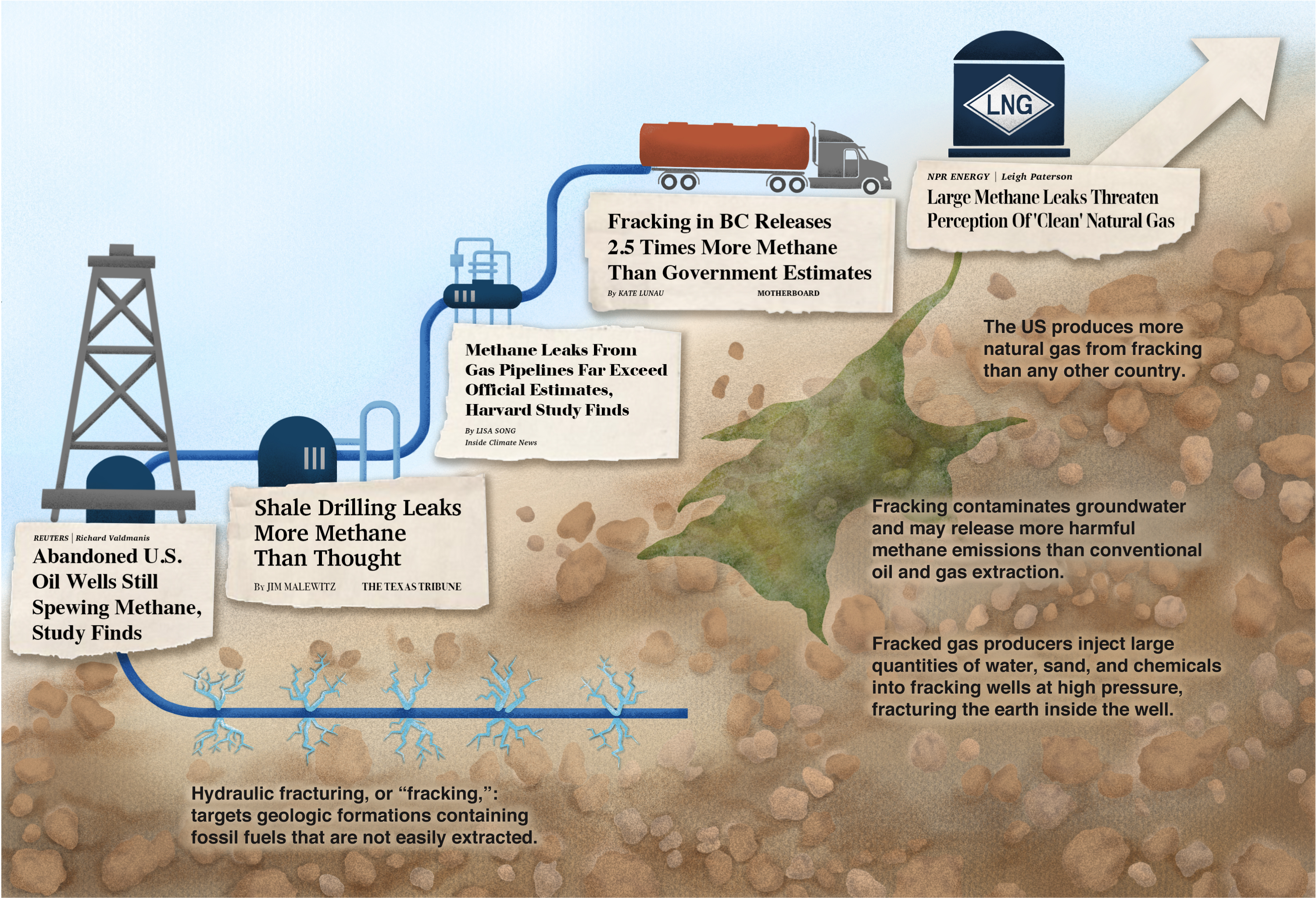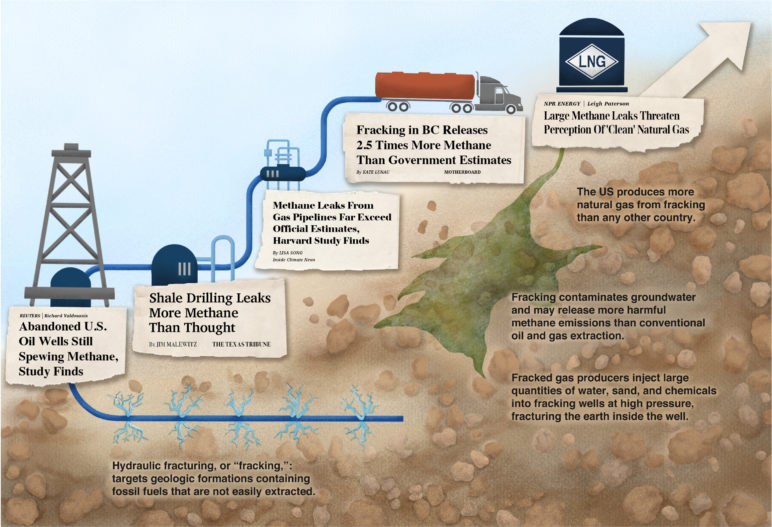Methane, the primary component of fracked gas, is a highly questionable solution for decarbonization or reducing greenhouse gas emissions. Fracked gas is commonly purported to be a “cleaner” alternative to other fossil fuels but that notion comes from looking at only a pixel in the full emissions picture. Our common understandings are inaccurate. When researchers examine the full climate impact of natural gas, many conclude that it is not substantially better than other fossil fuels and under some circumstances may even be worse.
It’s true that fracked gas does reduce non-greenhouse gas (GHG) pollutants like particulate matter and sulfur dioxide. But we have to challenge the notion that we should build more large-scale fracked gas infrastructure instead of choosing solutions that reduce those pollutants without introducing more methane—“CO2 on steroids”—into the atmosphere.
This is part of a trilogy of articles to provide depth and context to methane leaks. Read the other pieces in this series:

What is methane?
Methane (CH4) makes up 85 to 95 percent of natural gas and it is the second most abundant greenhouse gas after carbon dioxide (CO2). It is found in oil fields and coal basins, where it is sometimes intentionally “vented” into the atmosphere during oil or coal extraction. Venting can occur all along the supply chain: at drilling sites, pipelines, and processing and storage sites (including the infrastructure that refines and transports gas to industrial and residential customers). “Fugitive emissions”—unintentional leaks from natural gas distribution infrastructure such as drilling sites, pipelines, and compressor stations—add more unburned methane into the atmosphere.
Methane is a very potent greenhouse gas. Greenhouse gases (GHG) affect the Earth’s temperature and climate system. They absorb some frequencies of infrared radiation emitted from the Earth’s surface, trapping heat in the atmosphere that would otherwise go out into space.
There are naturally occurring methane sources but for this analysis, it’s most relevant and critical to talk about the emissions produced from human activity. We will discuss them in terms of warming potential rather than mass or volume because while human activities release less methane than carbon into the  atmosphere, methane is many times more potent than CO2 at trapping heat, meaning that emissions volumes do not need to be nearly as high to have serious climate consequences. Methane emissions contribute to about a third of today’s man-made GHG warming, according to the Environmental Protection Agency (EPA), even though they account for only 10 percent of annual US emissions and 20 percent of global emissions1.
atmosphere, methane is many times more potent than CO2 at trapping heat, meaning that emissions volumes do not need to be nearly as high to have serious climate consequences. Methane emissions contribute to about a third of today’s man-made GHG warming, according to the Environmental Protection Agency (EPA), even though they account for only 10 percent of annual US emissions and 20 percent of global emissions1.
Methane’s heat-trapping power is not its only nuisance. It can react with other chemicals in the atmosphere to form ozone, the primary component of smog which is another powerful greenhouse gas. Ozone has created air quality issues in areas near natural gas drilling sites and has pushed the air quality in some rural areas well past federal clean air standards. Higher global concentrations of methane may significantly increase ground-level ozone, even in areas nowhere near natural gas drilling sites.
Methane affects atmospheric chemistry in other negative ways as well. Methane leaves the atmosphere primarily through oxidization, which is a reaction with hydroxyl radicals (OH) that forms water vapor and CO2. Hydroxyl radicals are naturally occurring, highly reactive molecules that act like a “detergent,” cleaning methane and many other pollutants from the atmosphere. By reacting with hydroxyl radicals, methane reduces the amount of “detergent” available to clean other types of pollutants.
Global Warming Potential: 20 years vs. 100 years
Investigations into the effect of methane on climate change reveal seemingly conflicting figures. Some sources will state that methane has a heat-trapping power nearly 90 times greater than CO2, while others cite a heat-trapping power around 30 times greater than CO2. These aren’t opposing claims—the sources are simply looking at the global warming potential of methane over different time frames. 
Global warming potentials, commonly referred to as GWP, were established to allow comparisons of greenhouse gas impacts. The global warming potential of a gas is a measure of how much energy (heat) the gas will absorb in the atmosphere over a given time period compared to how much heat the same amount of CO2 would absorb. The larger the GWP, the more a greenhouse gas will warm the Earth compared to CO2. Since carbon dioxide is the baseline to which other gases are compared, it has GWP of one. If methane gas has a GWP of 87, it means one ton of methane produces the same average warming as 87 tons of CO2.
Different gases persist in the atmosphere for different lengths of time, so the comparison must also be based on a time frame. While CO2 can remain in the atmosphere for centuries, methane is more quickly removed from the atmosphere by natural processes. As a result of oxidization and a few other processes that remove much smaller amounts of methane from the atmosphere, methane stays in the atmosphere for, on average, about 12 years. One helpful way to think about atmospheric life is this: if a proposal for a fracked gas project has an expected life span of 60 years, the plant’s methane emissions would live in the atmosphere for approximately 72 years. Atmospheric processes would convert these emissions to carbon dioxide on a rolling basis.
 There are many atmospheric processes that impact methane, and methane, in turn, impacts other climate-changing processes, so analyzing the precise global warming impact depends on which of several complex atmospheric processes are considered. In a 2009 study by scientists at NASA and Columbia University, researchers evaluated a range of atmospheric processes and compositions and estimated that methane’s global warming potential could be 79 to 105 times greater than CO2 over a 20-year time frame. Analyzing the GWP of methane over 100 years, they concluded methane’s GWP was 26 to 41 times higher than carbon dioxide.
There are many atmospheric processes that impact methane, and methane, in turn, impacts other climate-changing processes, so analyzing the precise global warming impact depends on which of several complex atmospheric processes are considered. In a 2009 study by scientists at NASA and Columbia University, researchers evaluated a range of atmospheric processes and compositions and estimated that methane’s global warming potential could be 79 to 105 times greater than CO2 over a 20-year time frame. Analyzing the GWP of methane over 100 years, they concluded methane’s GWP was 26 to 41 times higher than carbon dioxide.
The most recent Intergovernmental Panel on Climate Change (IPCC) report values methane’s 20-year GWP value at 86 and 100-year GWP at 34. The IPCC’s figures are widely accepted by experts and are the most commonly cited when discussing the climate impacts of greenhouse gases. As we learn more about methane and feedbacks in the climate system, methane’s GWP has continually increased. The IPCC’s 1995 report, for example, put methane’s 100-year GWP at 21. The GWP of methane increased by about 20 percent between the IPCC’s fourth and fifth assessment report, when the IPCC first included multiple feedbacks in the atmosphere that can cause methane to produce other gases that trap heat, like ozone and water vapor. The GWP of methane is also changing because our understanding of the warming potential of CO2 has improved over the last 20 years, as has our understanding of how long methane typically stays in the atmosphere before being converted into CO2.
Methane is CO2 on steroids. It spends roughly 12 years trapping atmospheric heat 87 times more effectively than CO2, then it becomes CO2 itself.
The time frame we choose to evaluate methane can have a big impact on both our policy decisions and our understanding of the basic environmental impacts of fracked gas projects. Not surprisingly, there is fierce debate over whether it’s best to look at the impact of methane over a 20-year time frame or over a 100-year time frame. The fossil fuel industry uses the 100-year time frame, at least in part because it makes methane appear less harmful. Scientists also tend to look at climate change data over longer time frames. But some argue the need to act quickly on climate change means we should pay as much attention to nearer-term impacts as 100-year impacts.
The debate over 20-year versus 100-year effects can sometimes distract from the essential fact that underlies both time frames: when the best you can say of natural gas’s climate impacts is that they are 34 times worse than CO2 over a 100-year time frame, perhaps natural gas is more of a problem than a solution.
Thanks to Adrian Down and Marcia Baker, who contributed research to this series.
This is part of a trilogy of articles to provide depth and context to methane leaks. Read the other pieces in this series:
Footnotes:
1. Note that here the EPA used values from the IPCC’s 4th Assessment Report (AR4), which gives methane a GWP of 25. The current understanding of methane’s GWP is 34, so the sentence reflects EPA’s number as a minimum rather than an equivalent. These EPA figures are also based on a 100-year global warming potential for methane. ↩











William Snelson
I want citation. Im sorry but there is no way outside of a lab that CH4 becomes CO2.
Kelsey Hamlin
In the atmosphere, which has O2 in it, the CH4 eventually disengages as a molecule (the hydrogens don’t stay on) and the leftover Carbon bonds with the O2 in the air, making CO2, and the hydrogens attach to 02, creating water. Here’s a nice video on the chemical reaction equation for these molecules as they would naturally occur outside a lab: https://www.youtube.com/watch?v=S8GjkD296gg
Tarika Powell
You are wrong, and there are several citations already in the article. Why would I provide you more when you didn’t click the ones I already provided?
Ignorance is sometimes a choice. I’ll leave you to your choice.
Eric Nielsen
The only citations in your article relating to conversion of methane to CO2 link to the dictionary definition of oxidation, but nothing specific to this question.
While it’s true that oxidation of methane _via combustion_ results in CO2 (via a significantly more efficient process than coal or oil combustion), your article is primarily about leaked methane, i.e. the methane that’s _not combusted_, and so I’m pretty sure that’s what Williams’ question refers to.
I’m certainly no expert, and I haven’t looked for long, but this article suggests that the products of the more gradual oxidation of methane in the atmosphere are formaldehyde and H2O, _not_ CO2: https://en.wikipedia.org/wiki/Atmospheric_methane
Tarika Powell
You’ll probably find what you’re looking for in this article from NASA’s Goddard Institute.
You can also find more information in two other sources linked in the sentences about oxidization – Kirschke’s study on global methane sources and sinks and the IPCC’s AR5 synthesis report.
I’ve added the NASA citation to the article since internet “debates” can rapidly spiral downward around topics when one party starts out aggressively absent underlying knowledge, as this person did.
Thanks!
Eric Nielsen
My impression was that you’re the one who first went to ad hominem attacks, which is where things really spiral down. I do agree his question wasn’t particularly polite, or well-worded (unless you consider a gas stove to be a laboratory).
Haven’t looked at the others, but the abstract to the Kirschke reference states that ozone is one product of atmospheric oxidation of methane, but not CO2.
More important than all that, the article is lacking some key context for figuring out whether natural gas is just more bad/business-as-usual, or an improvement over coal/oil that would justify its current as a transitional fuel, while we move toward carbon-free sources. The key context is how much leakage there is relative to the amount that’s actually converted to energy. There seems to be no question that if the methane isn’t released into the atmosphere (ie it’s converted to energy and CO2 the way it’s meant to be), that it’s a significantly better fuel than coal or oil.
Anyway thanks for an interesting read about an important subject.
Tarika Powell
I’m sorry that my article didn’t answer all your questions. It’s a very complex topic and it’s impossible to address everything at once. For what it’s worth, this series is an introduction and there will be lots more exploration of the various topics to come. We’ll dig more and more into the weeds as we go.
Only slightly OT, but I feel like I’ve seen the words “ad hominem attack” more in the last year, year and a half than in all the other years of my life combined. I never would’ve predicted that Latin would be used so often in comment sections. I really hope a linguist has been following this because I would love to know the recent journey of that phrase!
Balter
Yes methane is a better GHG than carbon dioxide (just about anything is) but its lower concentration means it is about the same. And all human output is less than 5% of both gasses. Anybody want to talk about the big one? Poisonous toxic water vapor… we must stop emitting H2O
William Wilson
GWP is double accounting. In terms of heating what counts is the total amount of gas at any given time NOT the length of time it remains. There are less than 2 ppm of methane in air, there are 400 ppm of carbon dioxide and 10,000 ppm of water vapour. The hype over methane is pure hysteria.
Kourosh Bagheri
Seems that there is an organized attempt to diminish methane’s contribution to global warming. It’s called American advertising … because 2/3 of American fossil fuels are made by fracking, a major contributor to methane emissions. Truth is that for the twelve years that methane is in the atmosphere it leads to 200 times more heat trapping than CO2. That makes it twice as important as CO2 for the time we have left on the planet.
Balter
Whenever I question that an increase from 0.03% to 0.04% carbon dioxide since the end of the Little Ice Age just doesn’t seem a plausible explanation for global warming the climate hysterians switch to methane. Never a peep about the most significant GHG by far, water vapor. There is no demonstrable experiment to show carbon dioxide is the “main driver” of climate change – only models massaged and tweaked by people who want badly to find it so + indeed who are paid precisely to find it so. Cap and trade is a tax on the poor paid to the wealthy (their estates, plantations and farms are declared “carbon sinks”) often paid into offshore accounts where it is not even taxed as the Paradise Papers show.
joseph wood
Need to let the rainforest alone and have less cattle nothing is wrong with turkey burger cattle land without trees is a big producer of methane. I plant trees in the jungle because people are constantly citing the trees maybe more hemp would help
Eric Nielsen
I don’t think there’s any question that methane becomes CO2 when it’s combusted (i.e., when we burn the natural gas for energy), which is what the youtube video you’re linking to refers to. Curiously, the article doesn’t discuss that at all, although the efficiency of that process relative to coal and oil is why natural gas is considered to be a lower carbon fuel than the others (see https://www.ucsusa.org/clean-energy/coal-and-other-fossil-fuels/environmental-impacts-of-natural-gas).
I took William’s question to relate to the conversion of methane to CO2 in the atmosphere, not via combustion–which the article claims is a natural process, but which I can’t find any evidence for. So I don’t think his question has been answered.
Tarika Powell
See my comment to you above. I’ve spent over a year researching this series. William was aggressively incorrect in under a minute. I don’t find much value in a conversation of that nature.
This series is about fugitive methane and life cycle analyses, and how we need to focus beyond combustion, so I don’t find it curious that the article doesn’t spend most of its time on combustion. It does address combustion and the relative CO2 emissions of oil, coal, and gas when combusted – it’s simply not true that the article doesn’t discuss that at all. I talk about it several times in the series.
Thanks for your comment.
John Young
And even more bad news: Climate change my be reducing our atmosphere’s ability to decompose methane. If so, we can expect an even greater methane problem over even greater timespans.
“Sharp rise in methane levels threatens world climate targets,” Robin McKie, 02-17-2019, The Guardian, https://www.theguardian.com/environment/2019/feb/17/methane-levels-sharp-rise-threaten-paris-climate-agreement?CMP=Share_iOSApp_Other&fbclid=IwAR1HOlYuDZe4jwwQG1StIDeKU7HGyUjsMSA9wNe1CGzI-B56je9hgHfcD2g
For more information about the research paper: https://agupubs.onlinelibrary.wiley.com/doi/abs/10.1029/2018GB006009?fbclid=IwAR2CMThccQEdr367k9i2kuYfomfwn5-95jkaVIVotrAP8XNuJ2N7BXHynng&
To read and/or download the 02-05-2019 38 page paper itself: https://agupubs.onlinelibrary.wiley.com/doi/epdf/10.1029/2018GB006009?fbclid=IwAR0CRgQeDJWSuq-yXFYI51dNw2nZ2cn4gK_eGDm7Iero_H4IphxCChcSOvs
“Plain Language Summary: The rise in atmospheric methane (CH4), which began in 2007, accelerated in the past four years. The growth has been worldwide, especially in the tropics and northern mid‐latitudes. With the rise has come a shift in the carbon isotope ratio of the methane. The causes of the rise are not fully understood, and may include increased emissions and perhaps a decline in the destruction of methane in the air. Methane’s increase since 2007 was not expected in future greenhouse gas scenarios compliant with the targets of the Paris Agreement, and if the increase continues at the same rates it may become very difficult to meet the Paris goals. There is now urgent need to reduce methane emissions, especially from the fossil fuel industry.”
Check out the SAVE RGV from LNG website at http://www.savergvfromlng.com/ and Facebook page at https://www.facebook.com/saveRGVfromLNG/.
Bedo Omy
Are we not at the end of the interglacial period?
John Abbotts
Thanks Tarika, for this article. I have seen different values in media reports on “CO2 equivalents” for methane, and you explain how those differences arose.
And Bedo, I am not sure what you question implies. But if you are thinking that global warming might prevent the next ice age, a 2009 Technology Review article debunks that idea, link at https://www.technologyreview.com/s/416786/global-warming-vs-the-next-ice-age/
The author concludes:
“Nature is as unforgiving to [humans] as it was to dinosaurs; advanced civilization will not survive unless we develop energy sources that curb the carbon emissions heating the planet today and help us fend off the cold when the ice age comes.”
Balter
Deliberately misleading – like carbon dioxide 95% of methane is from natural sources: bogs and any anaerobic activity. Essentially if organic matter is not rotting and producing carbon dioxide and water, it’s fermenting and producing methane. It has more of a greenhouse aptitude but less actual effect as it tends to be heavier than air and occurs at a far lower rate than carbon dioxide.
Mark taylor
It seems that nothing will do with this aspect of climate change as some have said we need both side of this to work together and stop point scoring and work together
Terry
Methane has no effect on temperature as a greenhouse gas as the infrared band is already saturated with Water Vapour
RoyalMC
I’m noticing a lot of hate going to Tarika, but also a little kindness. From what I am researching right now, I can conclude that methane is indeed very bad, in multiple ways. Why people say her articles are deceptive is beyond me, while yes, there are some faults, but the is expected in ANY article, no matter what, because no matter who you are, what you do, you have a bias. These articles are one of the least biased ones I’ve read yet and include citations, references to reputable sources that are often accurate, and on top of it, went above and beyond and took constructive criticism from people. What I haven’t seen reading these comments though, is how other forms of energy could be used to replace it, and how they affect the environment in turn. I understand this would be somewhat off-topic, but I’ve seen comments talking about why methane is still good when it is blatantly obvious that the very chemical reaction that produces heat and power, produces carbon dioxide and water, along with the being impurities making it MORE toxic with sulfur and other dangerous things. So before you decide to comment that these articles that Tarika decided to spend over a year researching to make are deceptive, bad, or even plain out wrong, think with your brain, not judgment.
-RoyalMC
(My name is what I usually go by in games, I prefer to stay anonymous)
Ian Robert Wickham Fontanini
Why do we ignore: sewers methane gas or wastewater treatment might be 2-5% global warmings total even JUST we only treat 20% of sewage worldwide plus in 2010 was first time sewer methane records at twice more there than treatment stage? I’m a Plumber/
remember methane gas no colour smell sos no tell tale signs left behind either there it!
JUST in 2014 sewer access hole methane level recorded too at 5% or could self ignite all and 1930 Boston sewers CBD level could’ve fuelled energy BUT power lines brought in? WoW IPCC not listed sewer cause VENT PIPE nil or null in void = Might BEE root cause!!!
Vincent
Wow, a lot of bad comments here from people who don’t want to accept scientific findings. Note that these findings (impact of CO2, CH4 atmosphere chemistry etc.) are not exotic or recent theories, but result from decades of lab experiment, observations from satellites, thousands of researchers and papers debating and trying to reproduce and invalidate hypothesis.
Yes, the focus on methane’s impact on climate change is a bit new, because public awareness started with CO2 and also it’s not that easy to measure.
Reducing methane impact is quite challenging as methane emissions are diverse, and not always well known. In Oil&gas, wells monitoring is key. Big leaks can be detected by satellite like there SRON methane plumes (lots of big plumes in middle-east)
In agriculture, the amount of methane produced by cattle can greatly vary based on breed, cattle feed, climate & land management. There are solutions, some of them partially proven (algae), but the road is still long. A good list of resources there methane and climate change